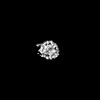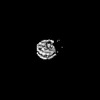[English] 日本語
 Yorodumi
Yorodumi- EMDB-51653: Subtomogram average of S. pombe 80S ribosomes from DEF tomograms ... -
+ Open data
Open data
- Basic information
Basic information
| Entry |  | ||||||||||||||||||
|---|---|---|---|---|---|---|---|---|---|---|---|---|---|---|---|---|---|---|---|
| Title | Subtomogram average of S. pombe 80S ribosomes from DEF tomograms acquired on cryo-FIB-lamellae based on Template Learning additional annotations non-overlapping with previous expert-validated annotations | ||||||||||||||||||
 Map data Map data | Subtomogram average of additional positive annotations from Template Learning that are missed by previous expert-validations | ||||||||||||||||||
 Sample Sample |
| ||||||||||||||||||
 Keywords Keywords | Complex / RIBOSOME | ||||||||||||||||||
| Biological species |  | ||||||||||||||||||
| Method | subtomogram averaging / cryo EM / Resolution: 18.0 Å | ||||||||||||||||||
 Authors Authors | Eltsov M / Harastani M | ||||||||||||||||||
| Funding support |  France, 5 items France, 5 items
| ||||||||||||||||||
 Citation Citation |  Journal: Nat Commun / Year: 2025 Journal: Nat Commun / Year: 2025Title: Template Learning: Deep learning with domain randomization for particle picking in cryo-electron tomography. Authors: Mohamad Harastani / Gurudatt Patra / Charles Kervrann / Mikhail Eltsov /  Abstract: Cryo-electron tomography (cryo-ET) enables three-dimensional visualization of biomolecules and cellular components in their near-native state. A key challenge in cryo-ET data analysis is particle ...Cryo-electron tomography (cryo-ET) enables three-dimensional visualization of biomolecules and cellular components in their near-native state. A key challenge in cryo-ET data analysis is particle picking, often performed by template matching, which relies on cross-correlating tomograms with known structural templates. Current deep learning-based methods improve accuracy but require labor-intensive annotated datasets for supervised training. Here, we present Template Learning, a technique that combines deep learning accuracy with the convenience of training on biomolecular templates via domain randomization. Template Learning automates synthetic dataset generation, modeling molecular crowding, structural variability, and data acquisition variation, thereby reducing or eliminating the need for annotated experimental data. We show that models trained using Template Learning, and optionally fine-tuned with experimental data, outperform those trained solely on annotations. Furthermore, Template Learning provides higher precision and more uniform orientation detection than template matching, particularly for small non-spherical particles. Template Learning software is open-source, Python-based, and GPU/CPU parallelized. | ||||||||||||||||||
| History |
|
- Structure visualization
Structure visualization
| Supplemental images |
|---|
- Downloads & links
Downloads & links
-EMDB archive
| Map data |  emd_51653.map.gz emd_51653.map.gz | 7.9 MB |  EMDB map data format EMDB map data format | |
|---|---|---|---|---|
| Header (meta data) |  emd-51653-v30.xml emd-51653-v30.xml emd-51653.xml emd-51653.xml | 15.7 KB 15.7 KB | Display Display |  EMDB header EMDB header |
| FSC (resolution estimation) |  emd_51653_fsc.xml emd_51653_fsc.xml | 6.5 KB | Display |  FSC data file FSC data file |
| Images |  emd_51653.png emd_51653.png | 99.6 KB | ||
| Filedesc metadata |  emd-51653.cif.gz emd-51653.cif.gz | 4.3 KB | ||
| Others |  emd_51653_half_map_1.map.gz emd_51653_half_map_1.map.gz emd_51653_half_map_2.map.gz emd_51653_half_map_2.map.gz | 7.9 MB 7.9 MB | ||
| Archive directory |  http://ftp.pdbj.org/pub/emdb/structures/EMD-51653 http://ftp.pdbj.org/pub/emdb/structures/EMD-51653 ftp://ftp.pdbj.org/pub/emdb/structures/EMD-51653 ftp://ftp.pdbj.org/pub/emdb/structures/EMD-51653 | HTTPS FTP |
-Validation report
| Summary document |  emd_51653_validation.pdf.gz emd_51653_validation.pdf.gz | 999.1 KB | Display |  EMDB validaton report EMDB validaton report |
|---|---|---|---|---|
| Full document |  emd_51653_full_validation.pdf.gz emd_51653_full_validation.pdf.gz | 998.7 KB | Display | |
| Data in XML |  emd_51653_validation.xml.gz emd_51653_validation.xml.gz | 11 KB | Display | |
| Data in CIF |  emd_51653_validation.cif.gz emd_51653_validation.cif.gz | 14.9 KB | Display | |
| Arichive directory |  https://ftp.pdbj.org/pub/emdb/validation_reports/EMD-51653 https://ftp.pdbj.org/pub/emdb/validation_reports/EMD-51653 ftp://ftp.pdbj.org/pub/emdb/validation_reports/EMD-51653 ftp://ftp.pdbj.org/pub/emdb/validation_reports/EMD-51653 | HTTPS FTP |
-Related structure data
- Links
Links
| EMDB pages |  EMDB (EBI/PDBe) / EMDB (EBI/PDBe) /  EMDataResource EMDataResource |
|---|
- Map
Map
| File |  Download / File: emd_51653.map.gz / Format: CCP4 / Size: 10.5 MB / Type: IMAGE STORED AS FLOATING POINT NUMBER (4 BYTES) Download / File: emd_51653.map.gz / Format: CCP4 / Size: 10.5 MB / Type: IMAGE STORED AS FLOATING POINT NUMBER (4 BYTES) | ||||||||||||||||||||||||||||||||||||
|---|---|---|---|---|---|---|---|---|---|---|---|---|---|---|---|---|---|---|---|---|---|---|---|---|---|---|---|---|---|---|---|---|---|---|---|---|---|
| Annotation | Subtomogram average of additional positive annotations from Template Learning that are missed by previous expert-validations | ||||||||||||||||||||||||||||||||||||
| Projections & slices | Image control
Images are generated by Spider. | ||||||||||||||||||||||||||||||||||||
| Voxel size | X=Y=Z: 3.37 Å | ||||||||||||||||||||||||||||||||||||
| Density |
| ||||||||||||||||||||||||||||||||||||
| Symmetry | Space group: 1 | ||||||||||||||||||||||||||||||||||||
| Details | EMDB XML:
|
-Supplemental data
-Half map: half map 2
| File | emd_51653_half_map_1.map | ||||||||||||
|---|---|---|---|---|---|---|---|---|---|---|---|---|---|
| Annotation | half map 2 | ||||||||||||
| Projections & Slices |
| ||||||||||||
| Density Histograms |
-Half map: half map 1
| File | emd_51653_half_map_2.map | ||||||||||||
|---|---|---|---|---|---|---|---|---|---|---|---|---|---|
| Annotation | half map 1 | ||||||||||||
| Projections & Slices |
| ||||||||||||
| Density Histograms |
- Sample components
Sample components
-Entire : S. pombe cells
| Entire | Name: S. pombe cells |
|---|---|
| Components |
|
-Supramolecule #1: S. pombe cells
| Supramolecule | Name: S. pombe cells / type: organelle_or_cellular_component / ID: 1 / Parent: 0 Details: This STA experiment used previously published cryo-ET data deposited in EMPIAR under entry number EMPIAR-10988 (original citation: https://doi.org/10.1038/s41592-022-01746-2). No sample ...Details: This STA experiment used previously published cryo-ET data deposited in EMPIAR under entry number EMPIAR-10988 (original citation: https://doi.org/10.1038/s41592-022-01746-2). No sample preparation or data collection was performed by the authors. |
|---|---|
| Source (natural) | Organism:  |
-Experimental details
-Structure determination
| Method | cryo EM |
|---|---|
 Processing Processing | subtomogram averaging |
| Aggregation state | cell |
- Sample preparation
Sample preparation
| Buffer | pH: 7 |
|---|---|
| Vitrification | Cryogen name: ETHANE |
| Details | This STA experiment used previously published cryo-ET data deposited in EMPIAR under entry number EMPIAR-10988 (original citation: https://doi.org/10.1038/s41592-022-01746-2). No sample preparation or data collection was performed by the authors. |
- Electron microscopy
Electron microscopy
| Microscope | TFS KRIOS |
|---|---|
| Details | This STA experiment used previously published cryo-ET data deposited in EMPIAR under entry number EMPIAR-10988 (original citation: https://doi.org/10.1038/s41592-022-01746-2). No sample preparation or data collection was performed by the authors. |
| Image recording | Film or detector model: GATAN K2 SUMMIT (4k x 4k) / Average electron dose: 3.0 e/Å2 |
| Electron beam | Acceleration voltage: 300 kV / Electron source:  FIELD EMISSION GUN FIELD EMISSION GUN |
| Electron optics | Illumination mode: OTHER / Imaging mode: BRIGHT FIELD / Nominal defocus max: 4.5 µm / Nominal defocus min: 1.5 µm |
| Experimental equipment |  Model: Titan Krios / Image courtesy: FEI Company |
 Movie
Movie Controller
Controller











 Z (Sec.)
Z (Sec.) Y (Row.)
Y (Row.) X (Col.)
X (Col.)





































